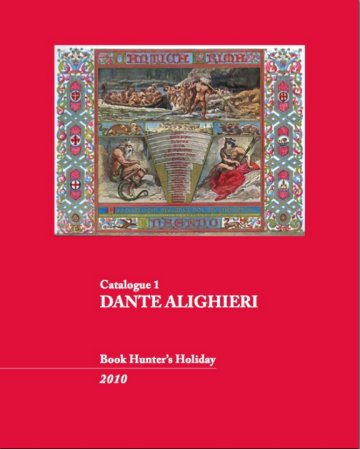

|
<<< Continued from previous page Never one to be deterred by the obvious, I forged ahead with my idea of producing a catalogue while having little idea of what "producing a catalogue" actually means. I learn a lot from reading other booksellers' catalogues, and I learn who other booksellers are because I read their catalogues. I wanted to add mine to the mix, get my name "out there" and introduce Book Hunter's Holiday to the rare book world, inexperience be damned. If nothing else, I would learn a lot about catalogues from the experience of building a meaningful collection on a tight budget, researching it, describing it, pricing it, and marketing it. I then decided to tempt the chance of epic failure by choosing to produce a catalogue of a well-known and generally expensive-to-collect author - Dante Alighieri. The choice of author was good. No other American booksellers already specialized in Dante. The problem was that I couldn't afford to buy the high-spot editions of Dante, the ones produced in 14th and 15th centuries, even if I was offered a 20% dealer discount. Undaunted (ignorant, really), I decided to assemble a collection of Dante editions from the past 300 years. The books would have to be illustrated or unusual in some way, and they would have to be affordable. I decided early on that no book in my catalogue would cost over $1,000 (that's really cheap when compared to the very early editions of Dante, which can run into the hundreds of thousands of dollars). Perhaps I could try to introduce new high-spots to collectors who had previously been focused on incunabula. Perhaps I could show new collectors that you don't have to have a million dollars to be a book collector with a meaningful collection. I decided that my catalogue was either the dumbest or the smartest idea I'd had in a while, and that the marketplace would be the ultimate judge. It took me three years to complete my first catalogue, which only has 65 books. I did it in small doses, between selling books at book fairs, online, and taking care of my family. I don't recommend that you follow my timeline, but I am sure you should make the time to produce catalogues, whether print or electronic, and get your brand established in the marketplace. For those of us who do not have open shops, the catalogue is our public persona. I'm happy to say that my first catalogue, which I released in 2010, three years after I started it, was warmly received and sold about 60% of the books in the first two months. The lesson here: Do your research, do your best, and don't doubt yourself. You can read some of the story of my Catalogue #1: Dante Alighieri in subsequent articles, and, if you are a glutton for punishment, you can check out the category called "Catalogues" on my blog and read about the development of the catalogue as it actually happened.

Click here to download the complete PDF catalog. Next Month: What Makes a Good Antiquarian Book Catalogue?
< to previous article
to next article >
Questions or comments?
| Forum
| Store
| Publications
| BookLinks
| BookSearch
| BookTopics
| Archives
| Advertise
| AboutUs
| ContactUs
| Search Site
| Site Map
| Google Site Map
Store - Specials
| BookHunt
| BookShelf
| Gold Edition & BookThink's Quarterly Market Report
| DomainsForSale
| BookThinker newsletter - free
Copyright 2003-2011 by BookThink LLC
|

|
|